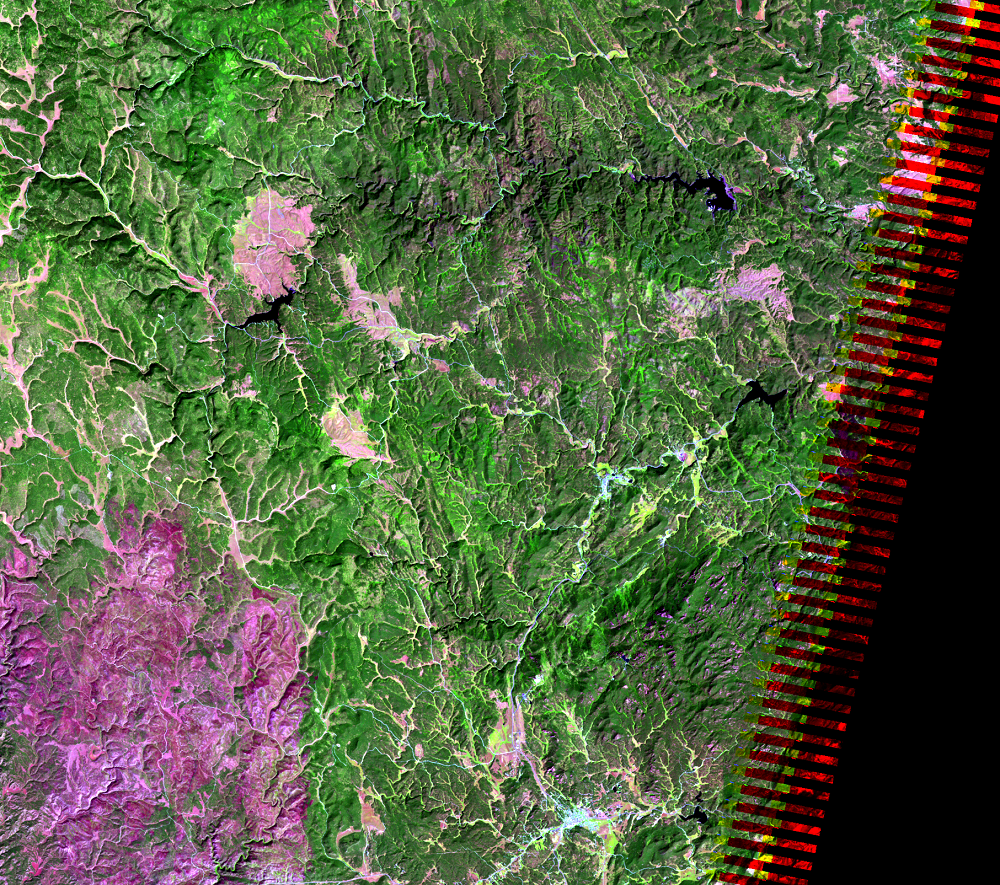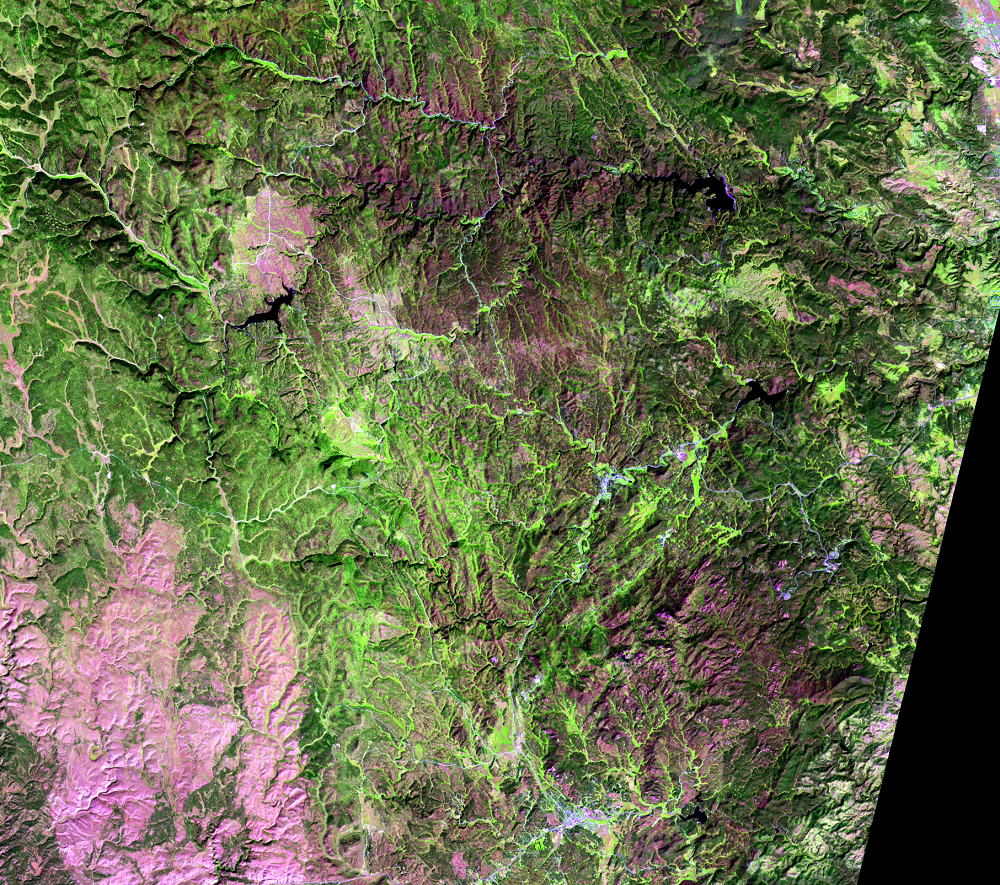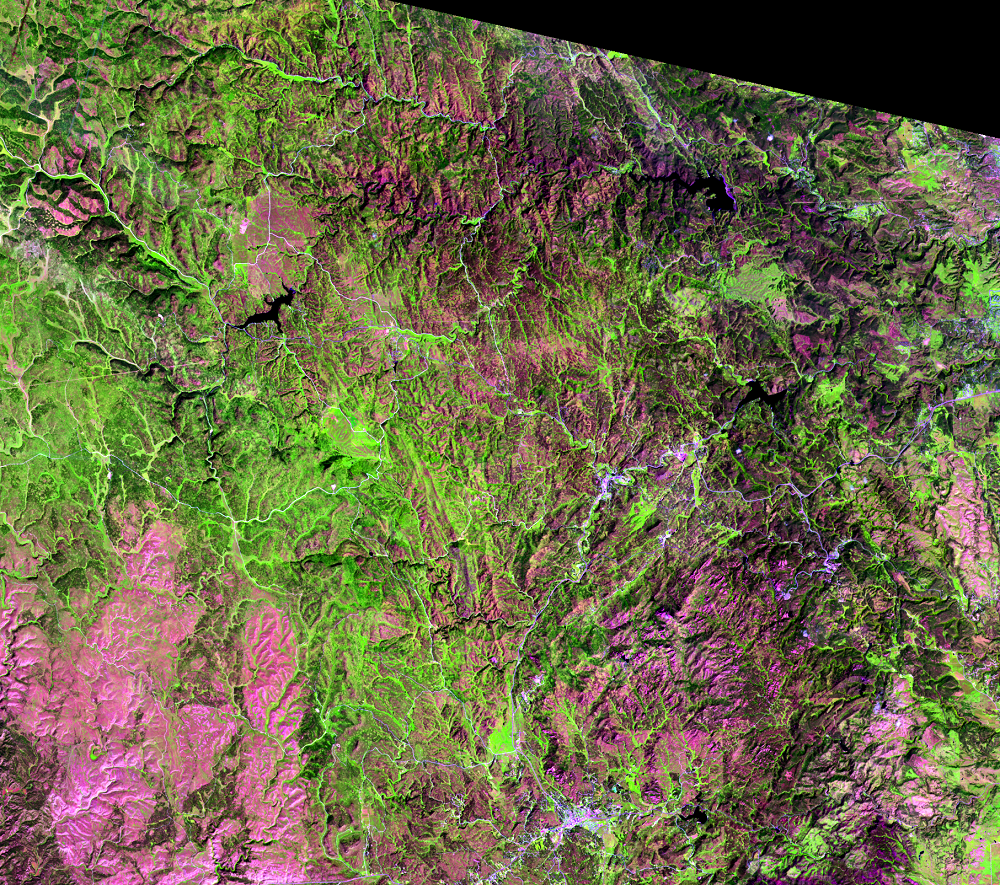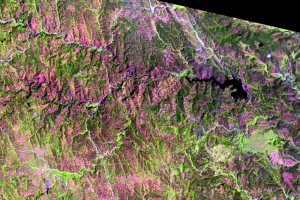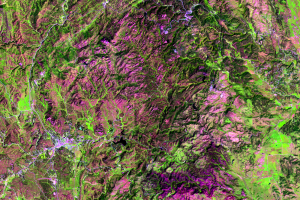
Black Hills, SD, USA
Earth Resources Observation and Science (EROS) Center - Earthshots
We can’t see bugs from space, but we can see the effects of insect infestation in Landsat imagery. An unprecedented mountain pine beetle epidemic started in the Black Hills of South Dakota in 1996 and has damaged about 430,000 acres of forest land. The pine beetle, about the size of a grain of rice, is killing ponderosa and other pines throughout the Black Hills.
Normally, the mountain pine beetle contributes to the health of a forest by infesting and killing older and stressed trees, which helps make the forest more productive. However, the recent large outbreak is doing more harm than good. It can affect water quality. It can convert the forest from a carbon sink to a carbon source. And where insect outbreaks and forest disturbance caused by wildfire overlap, the effects can actually be both harmful and beneficial. All of the effects of an outbreak need to be monitored.
Mountain pine beetles usually live in small numbers. It’s normal for the population to boom occasionally, but the current epidemic is unprecedented. Beyond the Black Hills, pine beetle outbreaks have occurred extensively in many pine forests throughout western North America, from British Columba in Canada to New Mexico.
In these Landsat images, beetle infestation is typically indicated by a washed-out pinkish color as seen in the top center and lower right of the images. The more pronounced pink region in the lower left of these images is a burn scar from the Jasper Fire, which occurred in 2000.
Imagery
Downloads
Assal, T. and Sibold, J., 2013, Modeling mountain pine beetle disturbance in Glacier National Park using multiple lines of evidence: Association of American Geographers Annual Meeting, Chicago, IL, abstract accessed on July 14, 2016, at https://pubs.er.usgs.gov/publication/70118022.
Assal, T.J., Sibold, J., and Reich, R., 2014, Modeling a Historical Mountain Pine Beetle Outbreak Using Landsat MSS and Multiple Lines of Evidence: Remote Sensing of Environment, v. 155, p. 275–288.
Ball, J. and Allen, K., [n.d.], Identification of Mountain Pine Beetle Infested Trees: South Dakota Cooperative Extension Service, accessed on July 14, 2016, at http://www.fs.usda.gov/detail/blackhills/landmanagement/?cid=stelprdb5113978.
Black Hills Forest Resource Association, [n.d.], Mountain Pine Beetles: Black Hills Forest Resource Association, accessed on April 17, 2018, at http://www.bhfra.org/mountain-pine-beetles.
Laughery, C., 2018, A New Initiative Meant to Strengthen the Forest: SDPB Radio, accessed September 12, 2018, at http://listen.sdpb.org/post/new-initiative-meant-strengthen-forest.
Liang, L., Chen, Y., Hawbaker, T.J., Zhu, Z., and Gong, P., 2014, Mapping Mountain Pine Beetle Mortality through Growth Trend Analysis of Time-Series Landsat Data: Remote Sensing, v. 6, no. 6, p. 5596–5716.
Liang, L., Hawbaker, T.J., Chen, Y., Zhu, Z., Gong, P., 2014, Characterizing recent and projecting future potential patterns of mountain pine beetle outbreaks in the Southern Rocky Mountains: Applied Geography, v. 55, p. 165–175.
Mullen, K., Yuan, F., and Mitchell, M., 2018, The Mountain Pine Beetle Epidemic in the Black Hills, South Dakota—The Consequences of Long Term Fire Policy, Climate Change and the Use of Remote Sensing to Enhance Mitigation: Journal of Geography and Geology, v. 10, no. 1, p. 69-82, http://dx.doi.org/10.5539/jgg.v10n1p69.
National Park Service, [n.d.], Mountain Pine Beetle Action Plan: National Park Service, accessed on July 14, 2016, at https://parkplanning.nps.gov/projectHome.cfm?projectID=30488.
NPS, 2018, Mountain Pine Beetle: NPS, accessed September 12, 2018, at https://www.nps.gov/romo/learn/nature/mtn_pine_beetle_background.htm.
Perez, T., 2018, Entomologist reports Mountain Pine Beetle infestation is at a natural level: KEVN Black Hills Fox, accessed September 12, 2018, at http://www.blackhillsfox.com/content/news/Entomologist-reports-Mountain-Pine-Beetle-infestation-is-at-a-natural-level--468693093.html.
Rosner, H., 2015, The Bug That’s Eating the Woods: National Geographic, April 2015, p. 96–115.
South Dakota Department of Agriculture, 2012, Mountain Pine Beetle: South Dakota Department of Agriculture, accessed on July 14, 2016, at https://sdda.sd.gov/conservation-forestry/forest-health/mountain-pine-beetle/.
Thom, D., 2014, Mountain Pine Beetle: U.S. Department of Agriculture Forest Service, accessed on July 14, 2016, at http://www.fs.usda.gov/detail/blackhills/landmanagement/?cid=stelprdb5113978.
U.S. Geological Survey, 2016, Landsat—The watchman that never sleeps: U.S. Geological Survey Fact Sheet 2016–3045, 2 p., http://dx.doi.org/10.3133/fs20163045.
Walters, B.F., 2016, Forests of South Dakota, 2015: Resource Update FS-82. Newtown Square, PA: U.S. Department of Agriculture, Forest Service, Northern Research Station. 4p.

